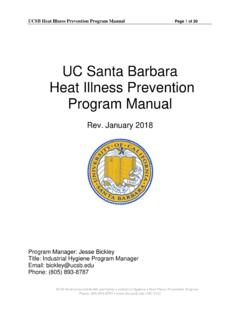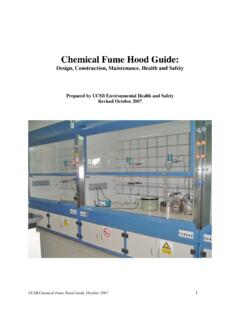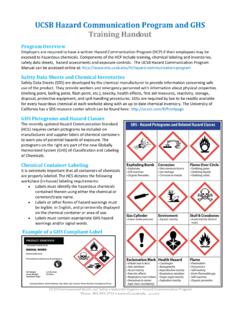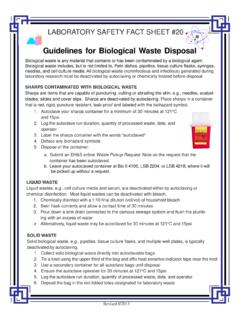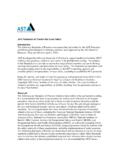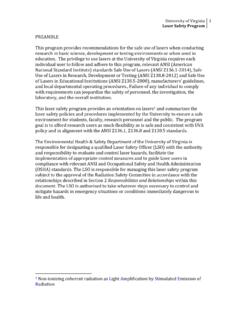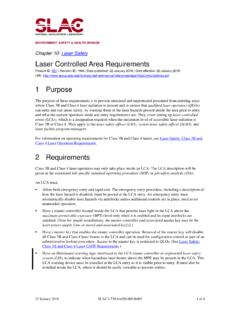Transcription of Laser Safety Manual - Environmental Health & Safety
1 Laser Safety Manual UCSB Environmental Health & SafetyTable of Contents Manual Safety Precautions for Class 3 and 4 Laser Inventory Section 1: Laser Safety Individual Laser Principal Laser Safety Laser Safety Officer (LSO)..5 Environmental Health and Safety (EH&S)..6 Medical Section 2: Classification and Hazard Class Class Class Class Laser Hazard Maximum Permissible Table Table Table Table Nominal Hazard Nominal Hazard Zone Laser Hazard Control Control Measures for the Laser Hazard Engineering Protective Interlocks on Protective Service Access Key Viewing Collecting Totally Open and Limited Open Beam Remote Interlock Beam Stop or Activation Warning Emission Protective Administrative Laser Safety Developmental Guidelines for a Laser
2 Safety Laser Safety Training for Operators and Record of Laser Safety Authorized Operating Personnel Alignment Control of Service Personnel Indoor Laser Controlled Warning Signs and Caution Danger Notice Personal Protective Eye Skin Factors Common to Laser Section 3: Non-Beam General Guidelines on Electrical Optical Radiation (other than Laser beam)..37 Ionizing Gas Dyes and Laser Dye/Solvent Control Precautions for Handling Additional Precautions for Dye Work with Moderate ( M ) with Strict ( S ) Protective Glove Other Appendices.
3 Appendix A Appendix B Suppliers of Laser Safety Equipment and Appendix C Laser Fundamentals and Characteristics of Laser The Lasing Types of Biological Effects of Photosensitizing Appendix D Glossary to Laser Introduction UCSB Laser Safety Manual 1 Introduction The Laser Safety Manual describes UCSB's Laser Safety program and provides guidance for the safe use of lasers and Laser systems. UCSB has adopted the elements of this program to assist researchers in conducting work with lasers as safely as possible while also meeting reasonable and legally defensible standards of precaution in the use of lasers.
4 The program is intended to minimize record keeping, follow accepted good practices, and provide useful resource materials for Laser users. Comments on the program and Manual content are always welcome and may be addressed to either the Laser Safety Officer or the Laser Safety Committee. The information contained in this Manual is based on the American National Standard for the Safe Use of Lasers, ANSI Although the standard is frequently cited in this Manual , for more thorough guidance the complete standard should be reviewed.
5 Manual Organization Laser users are strongly encouraged to purchase a copy of the ANSI standard (suppliers of the standard are listed in Appendix B). This Manual is divided into four sections (1) Laser Safety Program, (2) Classification and Control, (3) Non-Beam Hazards and (4) Appendices. Section One, Laser Safety Program, describes the program roles and responsibilities of the individual Laser users, principal investigators, Laser Safety Committee, and campus Administration. Section Two, Classification and Control, addresses Laser Safety based on the classification scheme and required control measures of the standard.
6 Section Three, Non-Beam Hazards, identifies the typical non-beam or ancillary hazards of Laser systems. The Appendices contains selected references, a list of suppliers of Laser Safety services and equipment, Laser Fundamentals and Bioeffects, and a glossary. Laser Fundamentals and Bioeffects presents a basic review of the characteristics of Laser light, the lasing process, and describes major types of lasers. Also included is information on the biological effects of Laser beam interaction with tissue, with emphasis on the eye and skin.
7 A list of Safety precautions for the use of Class 3 and 4 lasers is found on the next page. Following the Safety precautions list is a flowchart, presenting an overview of the campus Laser Safety program, and a Laser inventory form. The inventory form is used by the Laser Safety Committee to track the quantity and type of lasers on campus, and allows the Laser Safety Officer to review and assist principal investigators in classifying lasers and determining the controls required for their operation. Each principal investigator who possesses or acquires a Laser must complete and return an inventory form to EH&S.
8 Introduction UCSB Laser Safety Manual 2 Safety Precautions for Class 3 and 4 Lasers Class 3 (eye and specular reflection hazard) Never aim the Laser at a person s eye or stare at the Laser from within the beam. Keep the beam path above or below eye level for one seated or standing. Laser Safety eyewear may be needed if MPE (Maximum Permissible Exposure) is exceeded. Don t view beam directly with optical instruments unless a protective filter is used. Only experienced and authorized individuals are permitted to operate the Laser .
9 Secure the Laser from operation by unauthorized personnel. A key switch should be used if unauthorized personnel may gain access to the Laser . Always strive to enclose as much of the beam path as practical and to operate the Laser in a controlled access area. During alignment, avoid placing one s eye near the axis of the beam path, where specular reflections are most likely to occur. Alignment eyewear should be considered. Unnecessary specular ( , mirror-like) reflecting objects should be removed from the beam path.
10 Mount the Laser on a firm support to ensure the beam travels along its intended path. Post Laser hazard warning signs at entrances to Laser use areas. Class 4 (fire, eye and skin hazard, diffuse reflection hazard) Review your Laser Safety procedure prior to Laser operation. Strive to enclose as much of the beam as possible. A controlled access area is required. Entryway controls ( , warning lights, interlocks, protective eyewear, etc. ) are required. Assure that protective Laser eyewear is available and worn by all personnel within the Laser controlled area.


